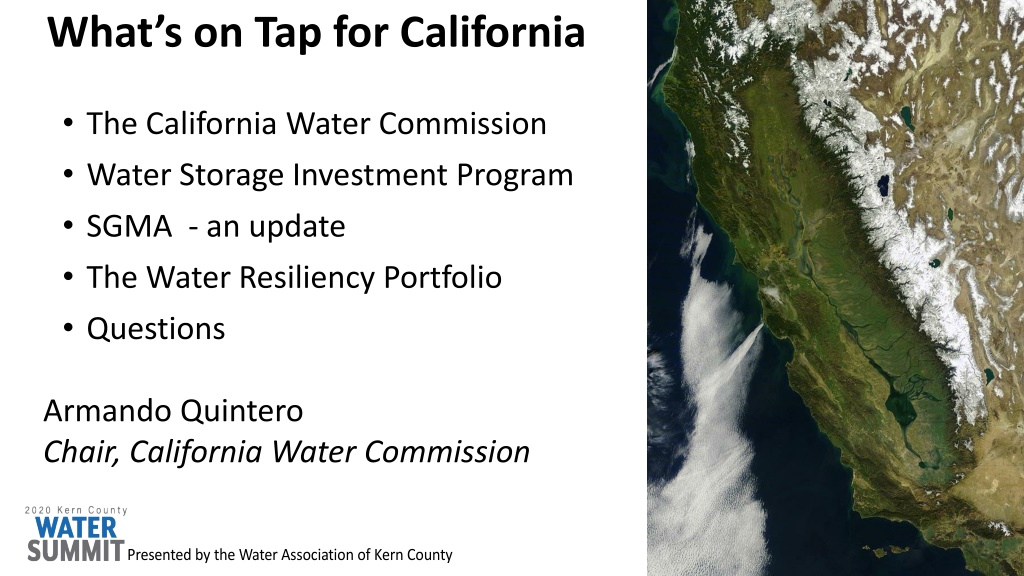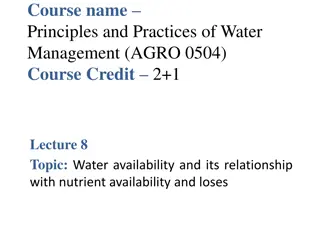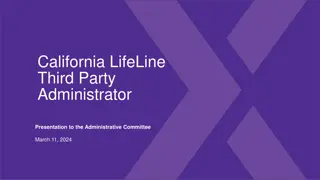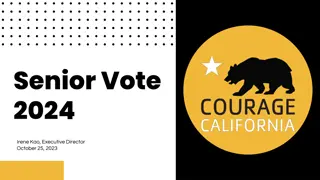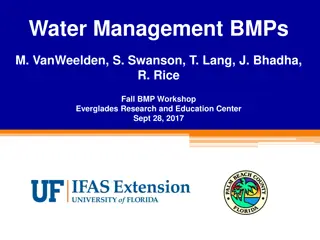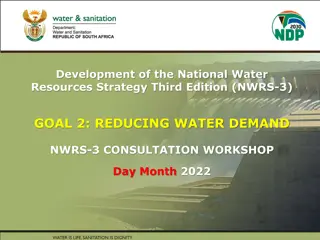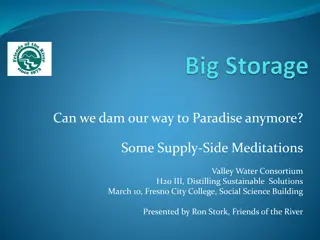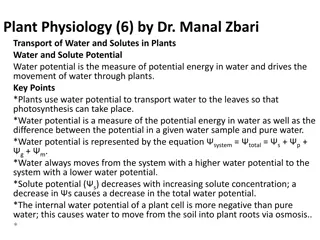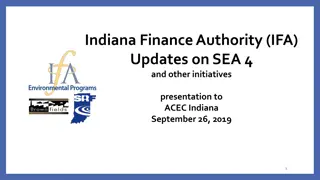Water Management Initiatives in California
Updates on California's water management initiatives include the Water Storage Investment Program, Sustainable Groundwater Management Act, and Water Resiliency Portfolio. The California Water Commission plays a key role in allocating funds and advising on water issues. Proposition 1 funds water quality, supply, and infrastructure improvements. The Water Storage Investment Program focuses on funding storage projects that offer public benefits such as ecosystem improvement and flood control.
Download Presentation

Please find below an Image/Link to download the presentation.
The content on the website is provided AS IS for your information and personal use only. It may not be sold, licensed, or shared on other websites without obtaining consent from the author.If you encounter any issues during the download, it is possible that the publisher has removed the file from their server.
You are allowed to download the files provided on this website for personal or commercial use, subject to the condition that they are used lawfully. All files are the property of their respective owners.
The content on the website is provided AS IS for your information and personal use only. It may not be sold, licensed, or shared on other websites without obtaining consent from the author.
E N D
Presentation Transcript
Whats on Tap for California The California Water Commission Water Storage Investment Program SGMA - an update The Water Resiliency Portfolio Questions Armando Quintero Chair, California Water Commission Presented by the Water Association of Kern County
California Water Basics California Water Basics Where California s Water Comes From Most of California s water comes from rain and snow that falls in the northern and eastern parts of the State Only Some Water is Available to Meet Demands About half of the 200 million acre-feet (MAF) of water that California receives is used by vegetation or goes to evaporation. Another 20 MAF stays in North and Central Coast streams Where California s Water Goes About 65 MAF is available to meet agricultural, urban, and Central Valley environmental needs.
Californias Largest California s Largest Water Reserves Water Reserves Groundwater is by far the State s largest water reserve, dwarfing the total capacity of all surface reservoirs, soils, and the Sierra snowpack. But how much can be used for drinking and crops isn t precisely known.
The California Water Commission Serves a The California Water Commission Serves a Central Role in California Water Management Central Role in California Water Management Nine members appointed by the Governor and confirmed by the State Senate. Provides a public forum for discussing water issues. Advises the Department of Water Resources. Approves DWR rules and regulations. Monitors the State Water Project and names new facilities. Adopts resolutions of necessity for DWR eminent domain proceedings. Tasked with allocating $2.7 billion from Proposition 1 for the public benefits associated with new water storage projects.
Proposition 1 Proposition 1 Water Quality, Supply and Infrastructure Improvement Act of 2014 Water Quality, Supply and Infrastructure Improvement Act of 2014 $7.545 B $7.545 B
Water Storage Investment Program (WSIP) Water Storage Investment Program (WSIP) Paradigm Shift in How Storage Projects Are Funded Funding directed to specific public benefits of new storage projects: o Ecosystem improvement o Water quality improvement o Flood control o Emergency response o Recreation
Water Storage Investment Program (WSIP) Water Storage Investment Program (WSIP) 12 applicants sought a total of $5.8 billion in WSIP funding Maximum Conditional Eligibility Decisions (MCED) made for eight projects Diverse set of projects moving ahead to prepare the state for climate change and future droughts. Potential to add 4.3 million acre-feet of new storage capacity both above and below ground to strengthen water resiliency. Will be state s largest investment in water storage in a generation.
Project Chino Basin Conjunctive Use Program Kern Fan Groundwater Storage Project Los Vaqueros Reservoir Expansion Project Pacheco Reservoir Expansion Project Sites Project South County Agriculture Program Temperance Flat Reservoir Project Willow Springs Water Bank Conjunctive Use Total MCED MCED Early Funding $206,900,000 $67,537,315 $459,000,000 $484,550,000 $816,377,686 $280,500,000 $171,330,000 $95,405,999 $2,581,601,000 $13,650,309 $24,200,000 $40,818,884 $54,000,000 Statewide Bond Costs (Treasurer s Office) Program Delivery (State Operations) $64,399,000 Total Proposition 1, Chapter 8 $2,700,000,000
Water Storage Investment Program (WSIP) Water Storage Investment Program (WSIP) WSIP regulations require the following in order to schedule a final award hearing: Contracts for the administration of public benefits Contracts for non-public benefit cost share Environmental documentation complete Required permits obtained Completed feasibility study
Water Storage Investment Program (WSIP) Water Storage Investment Program (WSIP) Contracts for the Administration of Public Benefits Department of Water Resources: Recreation, Flood Control, Emergency Response State Water Board: Water Quality Improvements California Department of Fish and Wildlife: Ecosystem Improvements
Water Storage Investment Program (WSIP) Water Storage Investment Program (WSIP) January 1, 2022, Statutory Progress Deadline: o Completed feasibility studies o Draft of environmental documents for public review o Commitment for at least 75 percent of non-program funding Commission will determine project feasibility. Review drafts of contracts for administration of public benefits. Final award hearings take place when requirements are completed.
SGMA SGMA Requires groundwater sustainability plans (GSP) in high- and medium-priority basins must be adopted and submitted by: January 31, 2020 for critically over-drafted basins January 31, 2022 for all other medium- and high-priority basins Does not include adjudicated basins
SGMA in 2020 SGMA in 2020 Increase in Outreach and Engagement Efforts: Educational Workshops GSA Forums Groundwater Summit Ensure awareness of DWR and other state programs that support SGMA implementation Create a venue for SGMA practitioners to exchange ideas Discuss nexus to Water Resilience Portfolio and other statewide groundwater policies
2020 Water Resiliency Portfolio 2020 Water Resiliency Portfolio In executive order N-10-19 (April 2019), Governor Newsom called for state agencies to create a water resilience portfolio . . . Shall together prepare a water resilience portfolio that meets the needs of California s communities, economy, and environment . . . State Agencies shaped the draft portfolio with public input and an inventory and assessment of various aspects of California water systems.
2020 Water Resiliency Portfolio 2020 Water Resiliency Portfolio The Governor asked that the portfolio encourage: Projects that offer multiple benefits Use of natural infrastructure such as forests and floodplains Innovation and new technologies Regional approaches among water users Examination of successful models from outside California Integration of investments, policies, and programs across state government Partnerships with local, federal and tribal governments, water agencies and irrigation districts, and other stakeholders
2020 Water Resiliency Portfolio 2020 Water Resiliency Portfolio The draft portfolio, released January 3, 2020, incudes 133 actions toward these goals: Maintain and diversify water supplies Protect and enhance natural systems Build connections Be prepared
2020 Water Resiliency Portfolio 2020 Water Resiliency Portfolio California Water Commission assigned primary role in 2 actions: Assess State role in financing regional conveyance Examine flood insurance beyond the national program California Natural resources Agency Secretary Wade Crowfoot appeared at February Commission meeting Commission is making plans to work on State role in financing regional conveyance this year. Final Water Resiliency Portfolio due out in March Commission will want to move around the State to hear from locals
